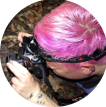-
Member Login
- Home
- About
- Institute Groups
- Membership
- Events
- News & Publications
- Institute Programs
- Resources
- Jobs Board
- Contact Us
- Site Info
Josie Stokes
Josie Stokes
Abstract | Recent Innovations in Microbat Mitigation on Road Projects in NSW
Roads and Maritime is responsible for maintaining over 18,000 kilometres of road network in New South Wales (NSW). Along the east-coast of NSW, roosting and breeding habitat for threatened microbats occurs in in a variety of Roads and Maritime assets. This includes structures such as historic timber truss bridges, concrete pipe and box-cell concrete culverts, and concrete bridges.
When these structures are removed or upgraded for maintenance or safety reasons, impacts on threatened bats such as the Large-footed Myotis (Myotis macropus) and Bent-wing bats (Miniopterus spp) can be significant enough to cause the extinction of local populations.
To minimise impacts of road projects on threatened microbats, our agency aims to restore roosting and breeding habitat by providing mitigation measures such as bat boxes which are subsequently monitored for use.
However, results from ecological monitoring indicate that wooden or recycled plastic bat boxes should only be considered as temporary construction mitigation measures as most microbat boxes deteriorate over time, and are sometimes not utilised by the target microbat species.
For the past six years, Roads and Maritime has investigated and documented the features of known roosting and breeding habitat for threatened microbats in a variety of concrete and wooden structures within the Northern Rivers of NSW, Australia.
Based on these known features, ecologists, bridge designers, biodiversity specialists, environment staff and project managers have worked together to include permanent roosting and breeding habitat in the design and construction of new concrete bridges and box-cell culverts. These designs have also been applied to the retrofitting of existing concrete culverts and recent ecological monitoring has recorded successful uptake and breeding events.
This presentation provides detail on the evolution of microbat mitigation in NSW, and the project that resulted in an Australian first- inclusion of permanent microbat roosting and breeding habitat in the design and construction of a new concrete bridge.
It also highlights the lessons learned during construction and illustrates how the culture of a road agency is changing to design and incorporate permanent roosting and breeding habitat for threatened microbats into new concrete structures.
Bio | Josie Stokes
 Josie has been the Biodiversity Specialist for NSW Roads and Maritime Services for the past 8 years. She is responsible for developing and implementing operational environmental policy and providing technical advice to project teams across NSW. When she is not DJing in venues around the country (and overseas), Josie can be found trudging around swamps surveying for frogs. She is also the curator for the Instagram Frog Friday account, raising awareness of worldwide amphibian conservation.
Josie has been the Biodiversity Specialist for NSW Roads and Maritime Services for the past 8 years. She is responsible for developing and implementing operational environmental policy and providing technical advice to project teams across NSW. When she is not DJing in venues around the country (and overseas), Josie can be found trudging around swamps surveying for frogs. She is also the curator for the Instagram Frog Friday account, raising awareness of worldwide amphibian conservation.
We acknowledge and value the rights and interests of Indigenous Peoples in the protection and management of environmental values through their involvement in decisions and processes, and the application of traditional Indigenous knowledge.

